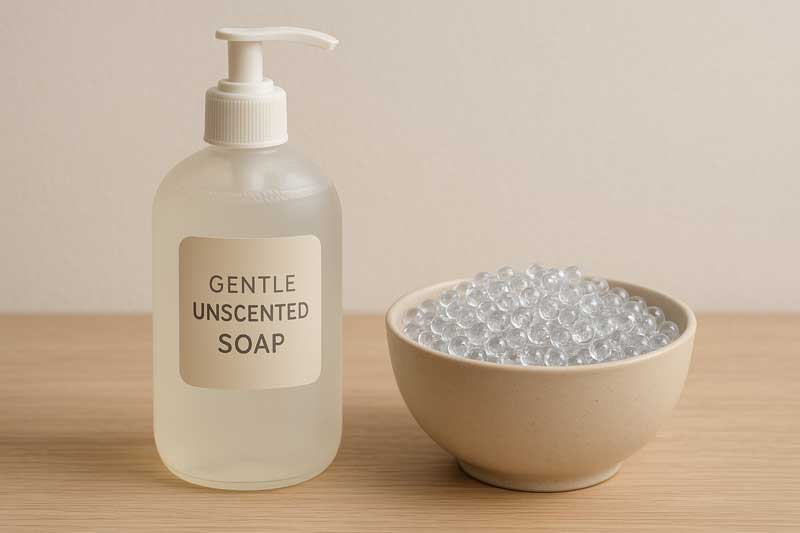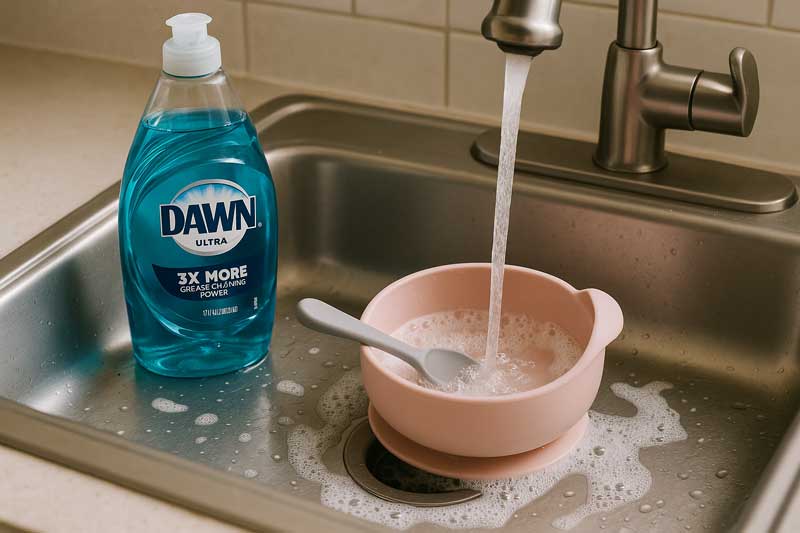Your baby's silicone teethers and toys are covered in drool and lint. You worry about using harsh chemicals on something your baby puts in their mouth, but you need them clean.
The best way to clean silicone beads is with mild soap and warm water. For a deeper sanitization, you can place them on the top rack of a dishwasher or boil them for five minutes. These methods are easy, safe, and highly effective.

As a manufacturer of silicone baby products, this is a question I answer daily. Procurement managers, who source products for major brands, need to provide clear, safe instructions to their customers. The beauty of high-quality silicone is its incredible simplicity. It’s a material designed for real-world use, which means it has to be durable, safe, and incredibly easy to maintain. Let's get into the specifics so you can clean with total confidence.
What is the best thing to clean silicone with?
Confused by all the cleaning advice online? Some say use vinegar, others mention baking soda. You just want to know what actually works and is completely safe for baby products.
The very best thing to clean silicone with is simply mild soap and warm water. It's gentle, effective at removing dirt and oils, and non-toxic, making it the perfect everyday cleaning solution for any food-grade silicone item.

In my factory, we emphasize that silicone's best feature is its non-porous surface. Unlike wood or fabric, it doesn't have tiny holes where dirt and bacteria can hide. This means you don't need harsh chemicals to get it clean.
Why Simple is Best
Mild dish soap is designed to break down oils and grease, which is exactly what you need to remove drool, milk residue, and grime. A gentle wash lifts these substances off the surface, and a simple rinse washes them away completely. There's no need for anything more complicated for daily cleaning.
Cleaning Methods Compared
While other methods work, they are often unnecessary. Here's a quick comparison:
| Cleaning Agent |
Effectiveness |
Safety for Silicone |
Best For |
| Mild Soap & Water |
Excellent |
Excellent |
Daily cleaning of all silicone products |
| Vinegar Solution |
Good (for hard water) |
Good |
Removing mineral deposits |
| Baking Soda Paste |
Good (for stains) |
Good |
Scrubbing off tough, dried-on food |
For 99% of situations, soap and water is the superior choice. It's what we recommend to our brand partners because it's foolproof, safe, and maintains the integrity of the silicone for years.
Can you use Dawn dish soap on silicone?
You have a bottle of Dawn dish soap right by the sink. It's great for dishes, but you wonder if it's too strong for silicone or if it will leave behind a soapy taste.
Yes, you can absolutely use Dawn dish soap to clean silicone. It is a very effective and gentle degreaser that works perfectly on food-grade silicone without causing damage or leaving harmful residues when rinsed properly.

This is a great question because it gets to the heart of everyday practicality. A client needs to know that the products he sources can be cleaned with common, trusted household items.
The Power of a Gentle Degreaser
Silicone surfaces can sometimes hold onto oils, whether from food, lotions, or skin. Dawn is especially good at cutting through this grease. This makes it an excellent choice for cleaning silicone cooking utensils, bibs with food residue, or teething toys that have been handled a lot. It breaks down the oily film, allowing it to be easily washed away.
Ensuring a Residue-Free Rinse
The concern about a soapy taste is valid for any soap. This happens if the soap is not rinsed off completely. Because silicone is non-porous, any residue will sit only on the surface. The solution is simple: rinse thoroughly. After washing with Dawn, rinse the silicone item under warm, running water for about 15-20 seconds. Rub the surface with your fingers while rinsing to ensure all the soap is gone. For extra certainty, you can do a final rinse in boiling water to remove any final traces.
Are silicone beads safe for babies?
Your baby wants to put everything in their mouth. You see silicone bead teethers everywhere, but you worry. Are they non-toxic? Are they a choking hazard? You need total peace of mind.
Yes, high-quality silicone beads are extremely safe for babies. They are made from 100% food-grade silicone, which is non-toxic and free from BPA, PVC, and phthalates. Reputable products are also constructed to prevent choking hazards.

This is the most important question for any parent or brand. The safety of our baby product line is our number one priority. We adhere to the strictest international standards, and I dedicate a lot of my time to educating clients on what true safety means.
Material Safety: The Non-Toxic Promise
The safety starts with the material itself. We only use platinum-cured silicone. This is the purest form available. It doesn't contain plastic fillers or harmful chemicals. This is verified through certifications like the US FDA and the even stricter European LFGB standards, which test extensively to ensure nothing leaches from the material.
Physical Safety: Beyond the Material
A safe teether is more than just safe material. It has to be constructed safely. For teething toys or pacifier clips made with beads, this involves:
- Strong Cord: The cord holding the beads must be durable and resistant to breaking.
- Individually Knotted Beads: Many designs feature knots between each bead. So, even if the cord were to break, only one bead would come loose, not all of them.
- Breakaway Clasp: Teething necklaces are for parents to wear, not babies. They should include a breakaway clasp that pops open if tugged hard, preventing any strangulation risk.
| Safety Feature |
Why It's Important |
| 100% Food-Grade Silicone |
Ensures the material is non-toxic and inert. |
| Certifications (FDA/LFGB) |
Provides third-party proof of material safety. |
| Strong Construction |
Prevents the toy from breaking and creating a risk. |
What is the best way to clean beads?
Your child's silicone beads need a deep clean, not just a quick rinse. You're unsure if the dishwasher is too harsh or if boiling is the only way to truly sanitize them.
The best way to clean silicone beads depends on your goal. Simple hand-washing is perfect for daily cleaning. For deep cleaning and sanitizing, both the dishwasher's top rack and boiling for five minutes are excellent, safe, and effective methods.

The versatility of silicone is one of its greatest strengths. It can handle a variety of cleaning methods without degrading. This gives parents and users convenient options.
Method 1: The Quick Daily Wash (Hand-Washing)
This is your go-to method. Just use warm water and mild soap. Lather them up, rub them together, and rinse thoroughly. It takes less than a minute and is perfect for cleaning up after a teething session or a dropped toy.
Method 2: The Easy Deep Clean (Dishwasher)
For a more hands-off approach, the dishwasher is fantastic. Place the silicone beads, teething toys, or pacifier clips in a utensil basket or a small mesh laundry bag on the top rack. The top rack is important as it's further from the heating element. Use your regular detergent. The hot water and powerful spray will clean and sanitize them perfectly.
Method 3: Maximum Sanitization (Boiling)
Boiling is the ultimate way to ensure sterilization. This is a great option if the toy was dropped in a particularly dirty place or if your baby has been sick. Simply bring a pot of water to a rolling boil, add the silicone items, and let them boil for 5 minutes. Use tongs to remove them and let them cool on a clean towel.
| Cleaning Need |
Best Method |
| Daily Cleaning |
Hand-Washing |
| Convenient Clean |
Dishwasher (Top Rack) |
| Full Sterilization |
Boiling (5 Minutes) |
Conclusion
Cleaning silicone beads is simple and worry-free. They are durable enough for boiling and dishwashers and can be quickly washed with soap, ensuring a safe and hygienic product for your baby.